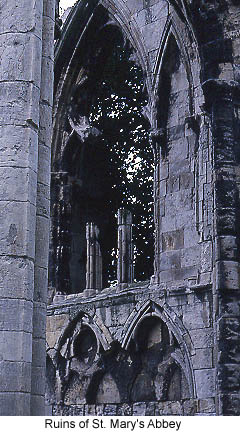TIMELINE: York
by Darcy Lewis
 71: Romans established the city, calling it Eboracum.
71: Romans established the city, calling it Eboracum.
120: Emperor Hadrian came to York to build his wall.
208: Emperor Septimus Severus ruled the entire Roman Empire from York for three years while campaigning in Scotland. Severus died in York in 211.
306: Emperor Constantius Clorus died while visiting the city. His son Constantine 'the Great' was then acclaimed as emperor by the army at York.
Ca. 388: The Romans left York.
625: York became the capital of Northumbria, changing its name to Eoforwic.
627: King Edwin of Northumbria was baptized and built a church on site of present York Minster.
866: Viking Ivar the Boneless defeated the Saxons and renamed the city Yorvik.
1066: King Harold of England defeated the Vikings at the pivotal Battle of Stamford Bridge near York.
1068: William the Conqueror marched north to York to solidify power.
1088: King William Rufus founded St. Mary's Abbey.
1132: Fountains Abbey, today Britain's largest monastic ruin, was founded.
1154: Ouse Bridge collapsed under a crowd gathered to welcome Archbishop William. Miraculously, no one drowned.
1220: Construction began on York Minster.
1226: City levied additional taxes and began construction of the stone walls seen today.
1396: King Richard II granted the City of York a Charter.
1471: York snubs King Edward IV by closing its gates on him.
1476: Richard, Duke of York, arrives at York's Bootham Gate with 5,000 men, sent by his brother King Edward IV to quell insurrection.
1539: St. Mary's Abbey was dismantled following Henry VIII's dissolution of the monasteries.
1553: The chain defense hung across the river between Davy Tower and the now-vanished Hyngbrig Tower was removed.
1564: Ouse Bridge collapsed and was again rebuilt.
1570: Guy Fawkes was baptized at St. Michael le Belfry Church in York.
1644: Parliamentary artillery launched a three-month siege of York.
1644: The Royalists were defeated at the Battle of Marston Moor near York.
1700: The huge medieval spire of St. Denys Church was destroyed by a lightning bolt.
1730: Mansion House, home to the annually elected Lord Mayor of York, was completed.
1739: Famous highwayman Dick Turpin was imprisoned and tried in York Castle, then executed at York Tyburn.
1800: The City Council applied to Parliament for permission to 'improve' the city by demolishing its walls. Walls and towers at St Leonard's Place and Skeldergate were demolished before the project halted.
1810: Construction began on the present Ouse Bridge.
1829: Religious fanatic Jonathan Martin set fire to York Minster.
1832: Roman fortifications were re-discovered.
1837: Legendary 'Railway King' George Hudson was first elected Lord Mayor of York, serving again in 1838 and 1846.
1839: The first railways arrived in York.
1845: Scarborough Bridge was completed.
1849: George Hudson declared bankruptcy.
1861: Lendal Bridge was completed, ending the livelihood of a ferryman who received compensation of £15 and a horse and cart.
1877: York Railway Station was completed.
1881: Skeldergate Bridge was completed.
1920s: York's first archeological excavations occurred.
1930: York's Roman bathhouse was discovered.
1942: Great York Air Raid occurred as the Luftwaffe attempted to cut the vital East Coast Main Line at York.
1942: Eden Camp was constructed to house German prisoners of war.
1969: Roman fortifications were excavated.
1971: York officially forgave disgraced 'Railway King' George Hudson, returning Railway Street to its earlier name of George Hudson Street.
1975: Skeldergate Bridge was opened for the last time. Its workings have since been removed.
2001: Millennium Bridge opened.
Related Articles
- The Treasures of York, by Pearl Harris
- https://www.timetravel-britain.com/articles/towns/york.shtml
- Where Emperors, Kings and Saints Have Walked: York Minster, by Julia Hickey
- https://www.timetravel-britain.com/articles/churches/minster.shtml
- Jorvik: The Viking City of York, by Brenda Ralph Lewis
- https://www.timetravel-britain.com/articles/towns/jorvik.shtml
- The Ghosts of York, by Jillian Schedneck
- https://www.timetravel-britain.com/articles/history/ghosts.shtml
- A Taste of Yorkshire: Yorkshire Pudding, Parkin and Pomfret Cakes, by Dawn Copeman
- https://www.timetravel-britain.com/articles/taste/taste02.shtml
- Uncovering the Archaeological Bounty of York, by Sara Polsky
- https://www.timetravel-britain.com/articles/towns/yorkdig.shtml by Sara Polsky
Darcy Lewis is an award-winning freelance writer whose articles have appeared in Writer's Digest, HGTV Ideas, Home, and the Chicago Tribune, among many other publications. Much of Darcy's knowledge of British history can be traced to her work as a history major specializing in pre-modern England at Brown University in Providence, RI. But her passion has deeper roots: Darcy's English mother, who is an endless treasure trove of stories about "how we do things at Home."
Article © 2005 Darcy Lewis
Photo © Moira Allen
| 